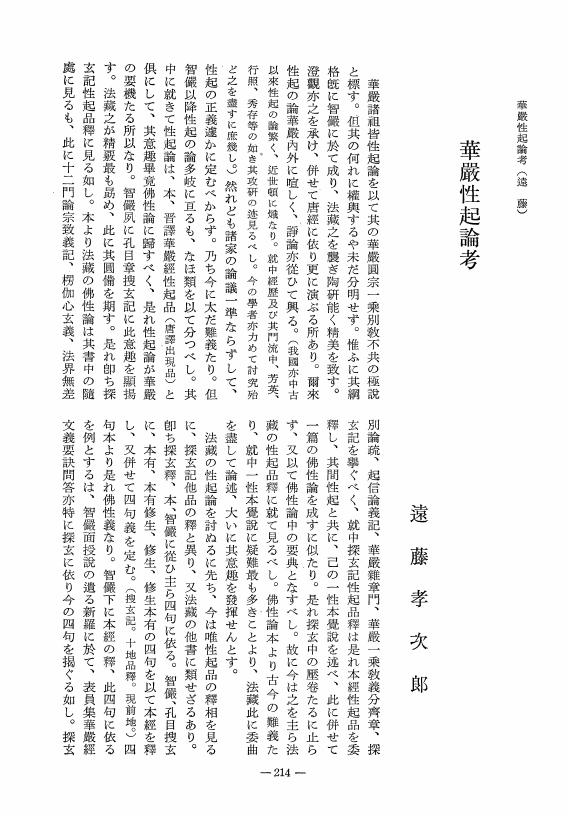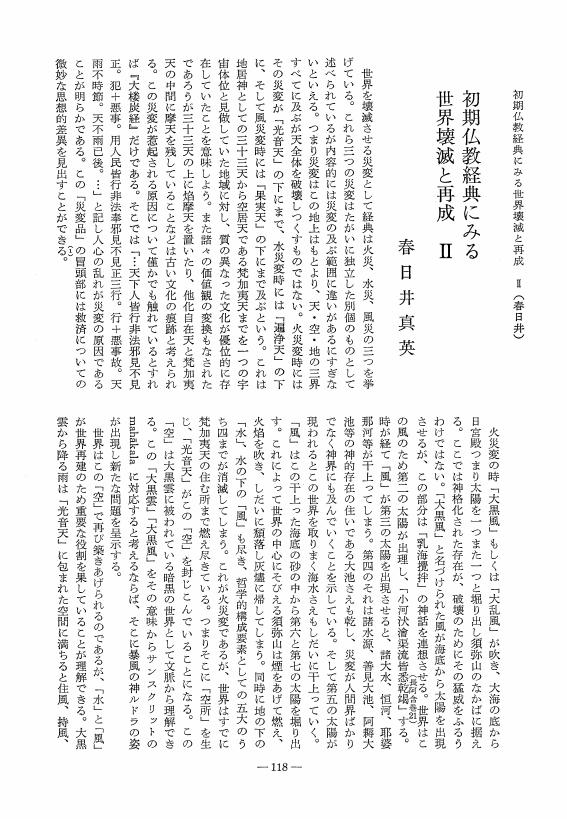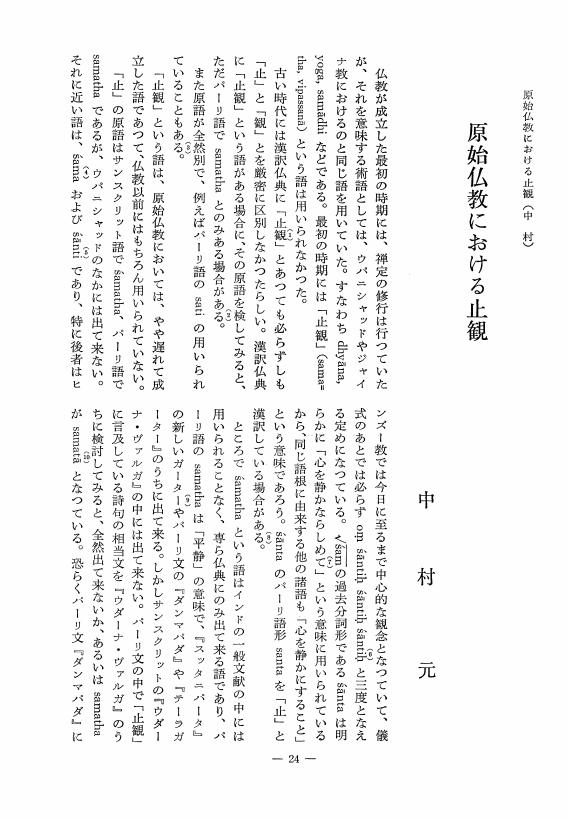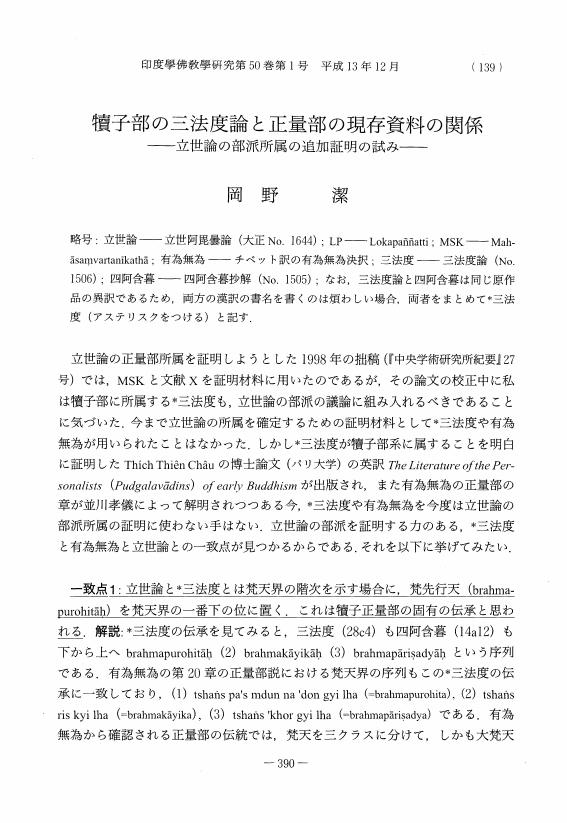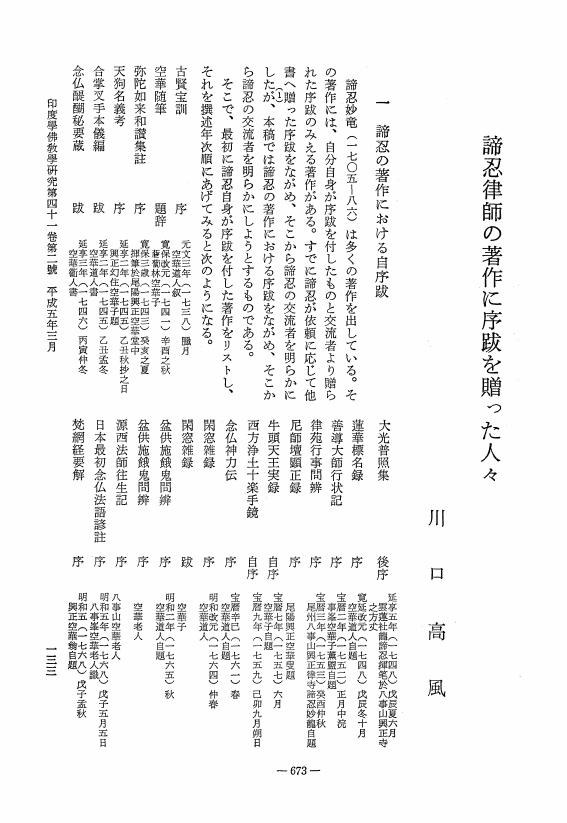1 0 0 0 OA 華嚴性起論考
- 著者
- 遠藤 孝次郎
- 出版者
- Japanese Association of Indian and Buddhist Studies
- 雑誌
- 印度學佛教學研究 (ISSN:00194344)
- 巻号頁・発行日
- vol.14, no.1, pp.214-216, 1965-12-25 (Released:2010-03-09)
1 0 0 0 OA 華嚴性起論考(續)
- 著者
- 遠藤 孝次郎
- 出版者
- Japanese Association of Indian and Buddhist Studies
- 雑誌
- 印度學佛教學研究 (ISSN:00194344)
- 巻号頁・発行日
- vol.15, no.2, pp.523-528, 1967-03-31 (Released:2010-03-09)
1 0 0 0 OA 性起思想の成立
- 著者
- 鎌田 茂雄
- 出版者
- Japanese Association of Indian and Buddhist Studies
- 雑誌
- 印度學佛教學研究 (ISSN:00194344)
- 巻号頁・発行日
- vol.5, no.2, pp.523-526, 1957-03-30 (Released:2010-03-09)
1 0 0 0 OA 如来蔵思想の淵源に就いて
- 著者
- 西 義雄
- 出版者
- Japanese Association of Indian and Buddhist Studies
- 雑誌
- 印度學佛教學研究 (ISSN:00194344)
- 巻号頁・発行日
- vol.19, no.1, pp.1-11, 1970-12-25 (Released:2010-03-09)
- 被引用文献数
- 1
1 0 0 0 OA 法蔵における如来蔵縁起の成立意義――『起信論』「立義分」の解釈を通して――
- 著者
- ウィックストローム ダニエル
- 出版者
- 日本印度学仏教学会
- 雑誌
- 印度學佛教學研究 (ISSN:00194344)
- 巻号頁・発行日
- vol.66, no.2, pp.516-519, 2018-03-20 (Released:2019-01-11)
- 参考文献数
- 8
Fazang (643–712) developed a unique Huayan philosphy placing the Dependent Origination of Dharmadhātu as the central ideology. However, separately from that based on the Discourse on the Awakening of Faith Fazang developed the ideology of the Dependent Origination of Tathāgatagarbha. In order to have a comprehensive understand of Fazang’s teachings, an understanding of the connection between these two ideologies is an important subject.In this paper, through an examination of his interpretation of the “Section on Establishing the Meaning” in the Discourse on the Awakening of Faith I propose to clarify, in connection to the Dependent Origination of Dharmadhātu, the meaning of Dependent Origination of Tathāgatagarbha, and the reason for which Fazang developed it.
1 0 0 0 OA 初期仏教経典にみる世界壊滅と再成 II
- 著者
- 春日井 真英
- 出版者
- Japanese Association of Indian and Buddhist Studies
- 雑誌
- 印度學佛教學研究 (ISSN:00194344)
- 巻号頁・発行日
- vol.31, no.1, pp.118-119, 1982-12-25 (Released:2010-03-09)
1 0 0 0 OA 原始仏教における止観
- 著者
- 中村 元
- 出版者
- Japanese Association of Indian and Buddhist Studies
- 雑誌
- 印度學佛教學研究 (ISSN:00194344)
- 巻号頁・発行日
- vol.23, no.1, pp.24-29, 1974-12-25 (Released:2010-03-09)
1 0 0 0 OA 玄奘三藏のアビダルマ學の特相
- 著者
- 春日井 眞也
- 出版者
- Japanese Association of Indian and Buddhist Studies
- 雑誌
- 印度學佛教學研究 (ISSN:00194344)
- 巻号頁・発行日
- vol.1, no.2, pp.478-482, 1953-03-25 (Released:2010-03-12)
1 0 0 0 OA 日本三論宗と新羅仏教
- 著者
- 福士 慈稔
- 出版者
- 日本印度学仏教学会
- 雑誌
- 印度學佛教學研究 (ISSN:00194344)
- 巻号頁・発行日
- vol.57, no.1, pp.538-531, 2008-12-20 (Released:2017-09-01)
1 0 0 0 OA 日本の初期法相宗に見る修行――道昭・行基・徳一を中心に――
- 著者
- 蓑輪 顕量
- 出版者
- 日本印度学仏教学会
- 雑誌
- 印度學佛教學研究 (ISSN:00194344)
- 巻号頁・発行日
- vol.70, no.2, pp.533-540, 2022-03-23 (Released:2022-09-09)
- 参考文献数
- 15
It is said that Dōshō 道昭, who introduced the Hossō idea to Japan, only stood up once every three or seven days when he entered meditation. This suggests that he may have practiced nirodha-samāpatti. His disciple, Gyōki 行基, is said to have had many spiritual experiences and mysterious intimations, which may have been related to the practice of śamatha. Tokuitsu 徳一 wrote the Shikan-ron 止観論 (“Treatise on Cessation and Observation”), and critical comments on it by Saichō mention several texts that the Hossō sect may have used for meditation. In addition to the Chinese translations of the Yogācārabhūmi 瑜伽師地論, the Sandhinirmocana-sūtra 解深密経, and the Abhidharmasamuccaya 雑集論, these texts include the translations by Yijing of the Zhiguanmen lunsong 止観門論頌, and Liumen jiaoshou lun 六門教授論. There is also a reference to the “18 Methods of Cessation and Observation” 十八門止観, which may have been a separate version of the one chapter of the Sandhinirmocana. Hossō’s view of cessation (śamatha) is that it is concentration on a single object, and his view of observation (vipaśyanā) is that it is detailed observation of the mind-action occurring in the same mind at that time. This is different from the Tendai understanding for cessation and observation. I posit that Tokuitsu’s treatise was written with this distinction in mind, in order to show the basic understanding of cessation and observation in the Hossō sect.
1 0 0 0 OA 犢子部の三法度論と正量部の現存資料の関係 -立世論の部派所属の追加証明の試み-
- 著者
- 岡野 潔
- 出版者
- Japanese Association of Indian and Buddhist Studies
- 雑誌
- 印度學佛教學研究 (ISSN:00194344)
- 巻号頁・発行日
- vol.50, no.1, pp.390-386, 2001-12-20 (Released:2010-03-09)
1 0 0 0 OA 四明知礼の皮肉髄得法説
- 著者
- 池田 魯參
- 出版者
- Japanese Association of Indian and Buddhist Studies
- 雑誌
- 印度學佛教學研究 (ISSN:00194344)
- 巻号頁・発行日
- vol.26, no.1, pp.312-316, 1977-12-31 (Released:2010-03-09)
1 0 0 0 OA 曹洞宗の報恩講式に関する考察 ――佛慈講式と洞上傳燈講式について――
- 著者
- ムロス ミヒャエラ
- 出版者
- 日本印度学仏教学会
- 雑誌
- 印度學佛教學研究 (ISSN:00194344)
- 巻号頁・発行日
- vol.58, no.2, pp.726-729, 2010-03-20 (Released:2017-09-01)
1 0 0 0 OA 諦忍律師の著作に序跋を贈った人々
- 著者
- 川口 高風
- 出版者
- Japanese Association of Indian and Buddhist Studies
- 雑誌
- 印度學佛教學研究 (ISSN:00194344)
- 巻号頁・発行日
- vol.41, no.2, pp.673-677, 1993-03-25 (Released:2010-03-09)
1 0 0 0 OA 信瑞纂『浄土三部経音義集』の書誌的整理 ――特に日本現存本について――
- 著者
- 前島 信也
- 出版者
- 日本印度学仏教学会
- 雑誌
- 印度學佛教學研究 (ISSN:00194344)
- 巻号頁・発行日
- vol.65, no.2, pp.634-637, 2017-03-20 (Released:2018-01-16)
- 参考文献数
- 4
The Jōdo sanbukyō ongishū 浄土三部経音義集 was written in 1237 by Kyōsaibō Shinzui 敬西房信瑞, who studied under one of Hōnen’s 法然 disciples. It contains analysis of terms in the three major sutras of Pure Land Buddhism.In Japan, there are nine kinds of manuscripts and three kinds of printed books. In this paper, I mention their bibliographic information and compare them, focusing on their marginalia. I therefore attempt to classify these sources.
1 0 0 0 OA 続高野聖考
- 著者
- 菊池 武
- 出版者
- Japanese Association of Indian and Buddhist Studies
- 雑誌
- 印度學佛教學研究 (ISSN:00194344)
- 巻号頁・発行日
- vol.42, no.1, pp.30-34, 1993-12-25 (Released:2010-03-09)
1 0 0 0 OA 古代インドにおける授与の諸儀礼と水
- 著者
- 梶原 三恵子
- 出版者
- 日本印度学仏教学会
- 雑誌
- 印度學佛教學研究 (ISSN:00194344)
- 巻号頁・発行日
- vol.65, no.1, pp.242-235, 2016-12-20 (Released:2017-10-17)
- 参考文献数
- 20
Since the Gṛhyasūtras, water has been involved in the rituals of giving gifts. As to the use of water at the giving of a girl to the suitor in the marriage ceremony, some Gṛhyasūtras preserve concrete prescriptions, while the Dharma texts prescribe it simply in the phrases “to give with water (adbhir dā)” or “to give being preceded by water (udakapūrva-)” without giving any details. Those simple phrases, which are attested since the younger Gṛhyasūtras and the Dharma texts, continue prevalently for other kinds of gift as well in post-Vedic texts.In Buddhist texts, the giving of donations and the giving of a girl in marriage are described principally in the same or similar expressions in the narratives: one is said to give a gift with a water-jar in hand. On the other hand, the enumeration of forms of marriage and wife in the Vinayas preserves a peculiar and concrete use of water at a certain type of marriage. Such a unique description might reflect the various uses of water at the rites of giving gifts before their descriptions were unified and simplified.
1 0 0 0 OA 『仏説十二門経』『仏説解十二門経』とそれらにおける道安の「序」との対応について
- 著者
- 洪 鴻栄
- 出版者
- 日本印度学仏教学会
- 雑誌
- 印度學佛教學研究 (ISSN:00194344)
- 巻号頁・発行日
- vol.60, no.3, pp.1294-1299, 2012-03-25
金剛寺の書写文献・安世高訳『仏説十二門経』『仏説解十二門経』は,1999年に発見されて以来ようやく十年を経た.その内容に対する研究は,いままで,イタリアの学者Stefano ZACCHETTIの幾つかの論文しかないのが現状である.ZACCHETTI氏は,この二つの写本について,安世高の著作としてはっきりと断定はできないが,ほぼ彼に属するものであると位置づけた.また,それに関して,なお幾つかの問題が残るものの,安世高以外の著者のものとして考えるのが難しい点が多いとも指摘している.氏の論証では,これらの写本は『仏説十二門経』『仏説解十二門経』,そして『仏説十二門経』に対する「解説」との三つの部分に分けられ,さらに『仏説十二門経』『仏説解十二門経』のそれぞれは,道安のいう『大十二門経』『小十二門経』に相当するという結論に至った.本稿では,氏の論証は新たな困難を引き起こすのではないかと指摘し,そして写本における氏の三つの分け方を検討した結果,『仏説十二門経』『仏説解十二門経』との二つの区分において十分あり得るため,新たに『仏説十二門経』に対する「解説」という第三区分を設定する必要はない.また,『仏説十二門経』は『大十二門経』に,『仏説解十二門経』は『小十二門経』に対応するのではなく,その反対,『仏説十二門経』は『小十二門経』に,『仏説解十二門経』は『大十二門経』に対応するという方が,正確なのではないかと筆者は指摘したい.
1 0 0 0 OA 道暹の「涅槃経疏私記」について
- 著者
- 坂本 広博
- 出版者
- Japanese Association of Indian and Buddhist Studies
- 雑誌
- 印度學佛教學研究 (ISSN:00194344)
- 巻号頁・発行日
- vol.20, no.2, pp.704-707, 1972-03-31 (Released:2010-03-09)
1 0 0 0 OA カビールの信と名号
- 著者
- 小林 圓照
- 出版者
- Japanese Association of Indian and Buddhist Studies
- 雑誌
- 印度學佛教學研究 (ISSN:00194344)
- 巻号頁・発行日
- vol.37, no.2, pp.523-529, 1989-03-20 (Released:2010-03-09)
- 参考文献数
- 6
